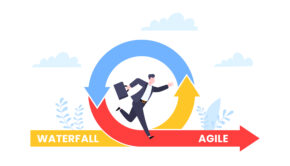Top 5 Custom Software Development Methodologies: Pros & Cons
Software development methodologies are considered as the backbone of the software industries that efficiently hold together processes, technologies, tools, and employees. We’re to help you to choose one of the best-suited software development methods.
In this article, we’ll discuss the top five custom software development methods that will help you make a grounded decision on what method fits your business and functional requirements.
Let’s dive right in.
5 Custom Software Development Methods
1. Waterfall Model
The waterfall model is one of the oldest methodologies. It substantially simplifies the software engineering process into a linear process diagram. The completion of the previous task is mandatory for the engineers to move to the next one. First created in 1970, Waterfall was considered as one of the prominent methodologies because of its plan-driven approach. It requires plenty of structure and documentation beforehand.
There are few main stages involved in the waterfall model: requirements, design, construction, deployment, testing and debugging, and maintenance.
Pros and Cons of Waterfall Software methodology:
Pros:
- This methodology is perfect for newbies because it is easy to understand.
- It is easy to manage because each phase has its deliverables and review process.
- This simple design allows for easy testing and analysis.
- It’s quick to implement for smaller projects where the requirements are well understood.
Cons:
- It’s only suitable when precise requirements are available.
- It’s not ideal for longer on-going or maintenance projects.
- With this methodology, you can’t produce any working software until the entire cycle is completed.
- Once the app is released, it is not possible to go back and modify it. In short, it is not flexible enough.
2. Agile Development Methodology
Based on iterative development, agile development methodology, where requirements and solutions advance through collaboration between cross-functional teams. It generally promotes a disciplined project management process that encourages frequent inspection and adaptation.
This process is recognized as an innovative approach used for articulating a well-organized project management process with an objective to minimize the iteration process that exists from one week to one month. The end goal of agile methodology is early software release with a low risk of bugs or issues.
This method involves six phases: Concept, Inception, Iteration/Construction, Release, Production, and Retirement.
Pros and Cons of agile development methodology:
Pros:
- High flexibility and quick testing
- High involvement of the end-user/client/product owner
- Promotes teamwork and cross-training
Cons:
- It has neither documentation nor set deadlines.
- More risk of sustainability, maintainability, and extensibility
- This methodology is customer-interaction dependent.
3. Rapid Action Development (RAD) Methodology
The objective of RAD methodology is to provide quicker and higher quality results than you could achieve over other methods. It’s quite similar to agile development methodology as it emphasizes working software and user feedback in favor of planning. In short, it is less talking and more testing.
Pros and cons of RAD methodology:
Pros:
- It helps reduce risks due to early issue identification and client feedback.
- Frequent feedback enhances transparency between the developers and the client.
- It allows less planning, and documentation helps speed up development.
- Users can interact with the prototype and result in a better quality product later on.
Cons:
- It has reduced features due to timeboxing even when features are pushed back to later versions to the last release in a short amount of time.
- This methodology is relatively new, therefore, risk methodology.
- It’s not suitable for small budget projects because modeling costs and automated code generation can be high.
4. DevOps Deployment Methodology
This software development method is the offspring of the Agile Software development process. It came into existence to match the increased software velocity. This methodology has the main focus on organizational change that enhances collaboration between the departments responsible for diverse segments of the development lifecycle, such as development, quality assurance, and operations.
The stages involved in DevOps Deployment methodology are development, testing, integration, deployment, and monitoring.
Pros and cons of DevOps Deployment methodology:
Pros:
- It’s focused on improving time to market, lowering the failure rate of new releases, shortening the lead time between fixes, and lessening disruption while maximizing reliability.
- To provide a smooth and reliable process, DevOps organization aims to automate continuous deployment.
Cons:
Taking into account of its benefits, there are a few disadvantages to DevOps:
- Sometimes customers don’t want continuous updates to their systems. Thus, it comes with drawback constant updates.
- Some companies have regulations, which require extensive testing before the project can move to the operations phase.
- There are some quality attributes that require human interaction that slows down the delivery pipeline.
5. Extreme programming methodology
Extreme Programming or XP methodology is used when dev teams need to create software in an unstable environment, such as customers’ requirements are rapidly changing. XP is more than just a series of steps to manage projects. That means it helps to work faster and collaborate more effectively. It involves frequent releases in short development cycles and checkpoints during which they might add new customer requirements.
Pros and cons of extreme programming methodology:
Pros
- There’s an abundance of client involvement that improves transparency and strengthens client-team relationships.
- It enables developers to establish schedules and plans due to frequent checkpoints.
- There are loads of frequent feedback that helps minimize risks and add improvements.
Cons
- XP methodology requires frequent meetings that can be expensive for both developers and customers.
- The frequent changes can be troublesome for developers. It also makes it complicated to calculate time and cost. Thus, the cost of changing requirements in the project can be high at a later stage.
Final Thoughts
Considering a methodology is not easy, a little research and planning can go a long way. To make a seamless process, all you can do is compile a list of your teams’ strengths and weaknesses and recognize which methodologies compliment your team’s working style and abilities. By doing so, it will help you extract the best methodologies that would best serve your client and projects. Trying out these software development methods on a trial basis or hiring a leading custom software company in Atlanta for better outcomes. You will gradually discover one of the best methodologies that would suit your needs.
















